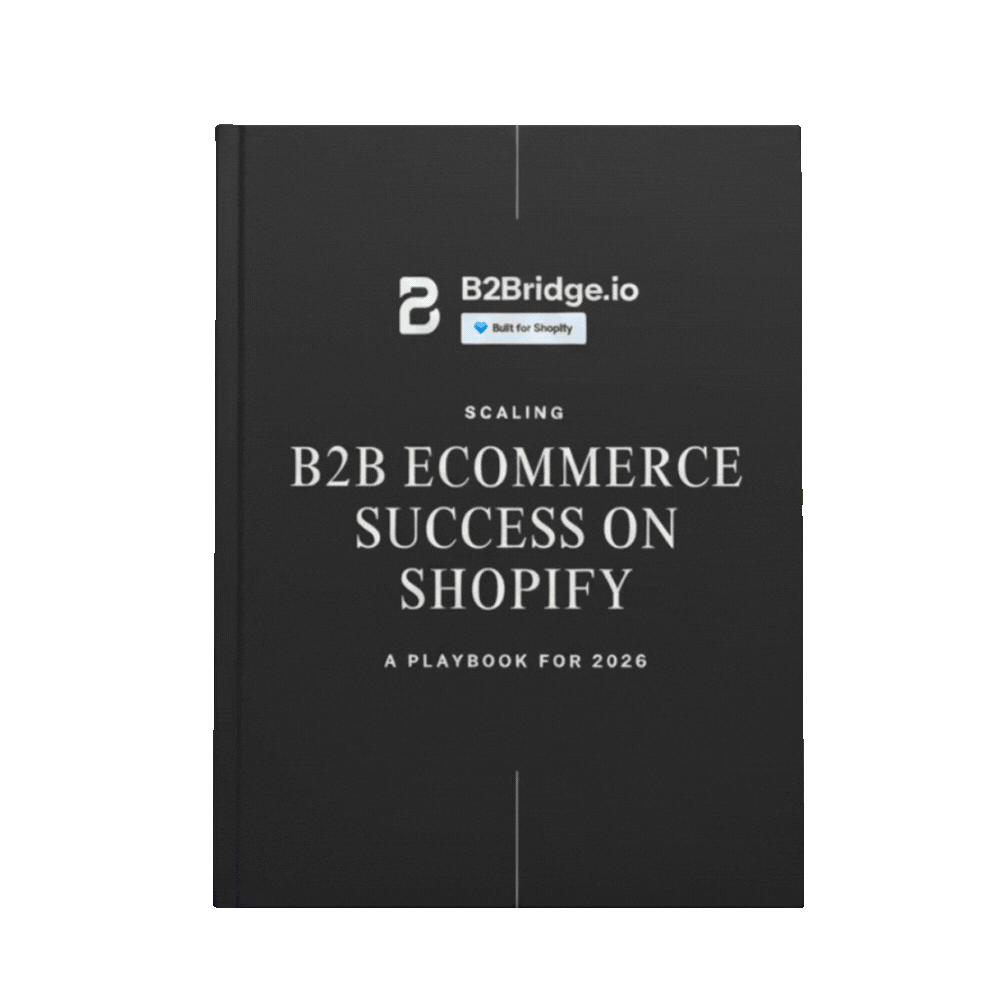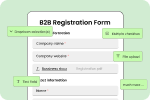Manufacturing is going digital and B2B Ecommerce is the catalyst for growth and efficiency. In 2025 the need to be online has never been more obvious. This guide will take you through the digital manufacturing revolution and why B2B Ecommerce is no longer a nice to have but a must. We’ll look at the trends shaping the B2B Ecommerce for manufacturers and the challenges those manufacturers face in making the changes to get into this digital world.
>> Read more: B2B Ecommerce Detailed Guide: What It Is and How to Start
Understanding B2B Ecommerce for Manufacturers
In its simplest terms, B2B Ecommerce for manufacturers means a digital platform selling goods to other businesses, be it distributors, wholesalers or industrial clients, rather than to the consumers themselves. This includes bulk orders, repeat business, manufacturing to order with possibly complicated pricing, contract terms and supply chain logistics.
How B2B Ecommerce for manufacturers differs from B2C and B2B
Unlike B2C Ecommerce which is all about user experience, impulse buys and standardized prices, B2B Ecommerce for manufacturers involves much bigger dollar values and negotiated prices that extend the time from buyer to contract. These platforms need to allow for product customization, order history management, credit terms and multi-user accounts.
Traditional B2B was all about sales reps, phone calls and emails; modern B2B Ecommerce makes that disappear with self-service tools, real-time inventory visibility and automated quoting so manual redundancy disappears and buyers can transact online all the way through.
>> Related topic: B2B vs B2C Ecommerce: Key Differences and Trends
The shift in B2B buyer behavior
Today’s business customers expect a digital first experience where they can research products, compare options and place orders online without talking to a salesperson. Omnichannel access – via website, mobile app, email and chat – is now table stakes to ensure consistency and flexibility.

Self-service is top priority with buyers expecting features like real-time tracking, digital invoicing and the ability to re-order with minimal friction. So, to stay competitive manufacturers need to modernize their sales approach and invest in Ecommerce solutions that match buyer behavior and industry digitalization trends.
Benefits of B2B Ecommerce for Manufacturers
Direct to Customer & Higher Margins: Selling direct business through an Ecommerce platform eliminates middlemen, thus enabling you to deal with the end customer on a more personal level. Better customer relationships also mean higher margins with less third-party fees and control over pricing and product positioning. Direct access shortens the feedback loop, enabling the quicker alteration of product offerings.
Brand Control and Awareness: Ecommerce is essential in ensuring that you present your brand consistently on all digital platforms. An independent Ecommerce channel offers an alternative to B2B distribution networks where, generally, the brand experience is diluted; to product and brand presentation, messaging, and content. This helps to grow the brand especially in the case of niche or specialty products.
Customer Data Collection and Personalization: With every customer engagement on the platform, an Ecommerce business collects critical data. You can analyze purchase trends, search behavior, and user preferences to target promotions, provide personalized product recommendations, and customize pricing for specific customers. This data supports decision-making processes and forms deeper, more loyal customer relationships.

Scalability and Operations: B2B Ecommerce systems streamline order processing, payment, inventory updates and customer service. They can scale to global markets, multiple currencies and regional regulations. Automation of routine tasks like reordering, quoting and invoicing frees up internal resources and reduces human error, making overall operations more efficient.
Innovation and Rapid Response to Market Needs: Digital platforms let you test new product lines, gather real time feedback and adapt to market changes. You can deploy updates instantly, launch time sensitive promotions or react to supply chain disruptions with agility. This is critical in fast moving industries.
>> Read more: 15 B2B Ecommerce Benefits For Wholesale Businesses
Key Features Manufacturers Need in an Ecommerce Platform
Complex product catalogs and configurations: Manufacturers sell products with multiple variants, customizable kits or serialized items that need parent-child SKU relationships and complex attributes like size, color or configuration options. An Ecommerce platform should support complex product data management with clear workflows and hierarchies, ideally with a Product Information Management (PIM) system to automate and maintain data accuracy and clarity for customers.
Customer specific pricing and catalogs: Ability to set different prices for different customers or customer groups is key. This includes role based pricing and personalized discounts to increase customer satisfaction and loyalty by offering tailored pricing and product visibility. Platforms should allow easy activation and automation of customer specific pricing rules.
Real time inventory and product information: Real time inventory tracking is important to prevent overselling and customer trust. The platform should update stock levels across all sales channels in real time, reflecting changes from orders, restocks or cancellations without disrupting the user experience. This requires a backend inventory management system, real time APIs and live communication channels like WebSockets to push updates to the frontend.
ERP, CRM and PIM integration: Integration with Enterprise Resource Planning (ERP), Customer Relationship Management (CRM) and Product Information Management (PIM) systems is key to syncing product data, customer info and inventory management. This means data accuracy, streamlined operations, personalization and time to market for new products.

Multiple payment and checkout options: Manufacturers need Ecommerce platforms that support multiple payment methods for global customers. This includes credit/debit cards, digital wallets like Apple Pay and Google Pay, bank transfers, buy now/pay later options and vouchers. More payment options increases conversion rates, reduces fraud risk and optimizes transaction costs. Platforms should allow easy customization of payment methods and checkout flows.
Self service portals and account management: Customers should have self service portals to manage their accounts themselves. Features include viewing order history, managing personal info, accessing knowledge bases and interacting with support communities or chatbots. This reduces support costs and increases customer satisfaction.
Marketplace integrations (Amazon, eBay etc.): To expand sales channels Ecommerce platforms should integrate with major marketplaces like Amazon and eBay. This allows manufacturers to sync product listings, inventory and orders across multiple platforms and simplify multichannel management.
>> Explore: 15+ Best Wholesale Distributors In USA You Shouldn’t Miss
How to Build an Effective Strategy B2B Ecommerce Platform for Manufacturers
Assessing business goals and digital readiness
- Know Your Audience and Their Needs: Who are your ideal customers, where are they and what are their needs? Research your competitors online presence and sales/marketing channels. Map the customer journey and identify pain points to solve with digital solutions.
- Set Clear Business Objectives: Analyze your current business stage and future goals. Have strategic sessions with leadership to define what sets your business apart and what to copy from competitors.
- Assess Resources and Budget: Look at your company’s capabilities and budget for Ecommerce. Total cost of ownership (TCO) of platforms, not just implementation costs.
- Build a Cross-Functional Digitalization Team: Get a team to manage digital transformation, allocate resources and review progress against measurable goals.
Choosing the right Ecommerce platform (BigCommerce, Adobe Commerce, Shopify Plus, etc.)
| Platform | Best For | Key Features | Pricing Model |
| Adobe Commerce (Magento) | Large-scale manufacturers with complex needs | Highly customizable, scalable, extensive B2B features, integration with ERP/CRM | Tiered, based on Gross Merchandise Value (GMV) |
| BigCommerce | Manufacturers seeking an all-in-one, scalable B2B solution | Robust B2B features, bulk ordering, multi-channel support | Monthly subscription tiers |
| Shopify Plus | Manufacturers starting or scaling with ease of use | User-friendly, centralized inventory and billing, SEO tools | Monthly subscription |
| OroCommerce | Mid to large enterprises needing complex B2B workflows | Open-source, customizable, integrated CRM, multi-organization support | Custom pricing, requires technical resources |
Note: Adobe Commerce requires more investment and technical know-how. BigCommerce and Shopify Plus offer user interfaces that are user-friendly and have B2B capabilities for all business scales. OroCommerce caters to very complex B2B scenarios with deep customization.
Designing a user-friendly, B2C-like experience for B2B buyers
- Make it easy for customers to find items: Clear menus and an intelligent search engine with predictive text, filters, and/or categories are required so that customers can get life the fastest.
- Make your site faster: A fast site is a site that runs smoothly. Keep it moving by compressing images, cleaning up code, and using CDNs.
- Customize the shopping experience: Like in B2C, B2B buyers appreciate customized features such as product recommendations, fast reordering, and price adjustments based on their accounts or purchase history.
- Support decisions with content: Provide product details, how-to guides, case studies, and customer reviews. Lead customers toward making informed decisions.
- Build trust with the security: Secure customer data and transaction procedures. This is the very foundation upon which B2B gains and maintains trust.
Automation for order processing, billing, inventory
- Automate order entry, billing, invoicing, inventory management to reduce errors and speed up.
- Ecommerce integration with existing ERP and CRM systems for data flow and real-time inventory updates.
Personalization of the buyer journey (recommendations, quick reorder, etc.)
- Use data to personalize product recommendations and promotions.
- Saved orders, quick reordering, customized catalogs/pricing based on buyer profiles.
- Self-service portal for complex B2B workflows like bulk ordering and multiple user roles.
Educational content and customer reviews
- Rich content that educates buyers about products and applications so they can make better buying decisions.
- Customer testimonials and reviews to build trust and social proof.
>> See more detail in: Best 20 B2B Ecommerce Examples: In-depth Review
Case Studies & Success Stories
Beardbrand – Elevating D2C with Headless Flexibility
Industry: Personal grooming products (beard oil, grooming tools)

Challenge: Fragmented sales channels and limited personalization; needed more control over UX.
Solution with Shopify Plus:
- Adopted headless commerce to build a faster, more customized front-end.
- Used automation tools for smart product recommendations and repeat purchase prompts.
- Built internal apps for better fulfillment and logistics control.
Results:
- +30% increase in conversion rate
- Consistent year-over-year growth
- Greater brand ownership and D2C margin optimization
Bombas – Scaling a Mission-Driven Manufacturing Brand
Industry: Apparel (socks and underwear manufacturer).

Challenge: Reliance on third-party retail limited brand visibility and control.
Solution with Shopify Plus:
- Transitioned to D2C Ecommerce model on Shopify Plus.
- Deployed advanced customer analytics and A/B testing for performance marketing.
- Leveraged platform flexibility to promote their “One Purchased = One Donated” mission.
Results:
- Hundreds of millions in revenue
- Over 50% customer retention rate
- Recognized as one of the fastest-growing sock brands in the U.S.
Ruroc – From Niche Helmet Maker to Global Brand
Industry: Motorcycle and snow sports helmets

Challenge: Needed a global Ecommerce infrastructure to handle flash sales, high traffic, and international demand.
Shopify Plus Solution:
- Migrated from Magento to Shopify Plus for faster performance.
- Built a headless commerce system to scale globally.
- Integrated Shopify Flow to automate order handling.
Results:
- Grew to 7-figure monthly revenue.
- Orders from 80+ countries.
- Zero downtime during product launches.
Future-Proofing B2B Ecommerce Manufacturer Operations
Composable and headless commerce: To keep up with changing buyer behaviour and complex B2B demands manufacturers are going composable and headless. Composable commerce lets you pick the best tool for each function – PIM, CMS, ERP etc – for maximum flexibility. Headless commerce decouples the front end user experience from the back end systems for faster interface development, omnichannel delivery and localised experiences without disrupting the core logic.
AI and automation for personalisation and efficiency: AI and automation are no longer optional – they’re essential for personalisation at scale and operational efficiency. For B2B Ecommerce AI can recommend products based on reorder patterns, suggest volume based discounts and dynamically adjust pricing based on customer profiles or inventory. Automation tools can streamline order workflows, fulfillment and customer service – reducing manual errors and speeding up response times.
Global expansion and cross border Ecommerce: Global expansion is a big growth opportunity for B2B manufacturers but it requires a robust infrastructure to manage cross border complexities. A future ready Ecommerce platform must support multi-currency transactions, localised tax and compliance rules and multilingual content to ensure a seamless buyer experience across regions. Plus alignment with regional data protection and trade regulations (like GDPR, VAT or sanctions compliance) is key to avoid costly penalties.
Transparency and ethical sourcing as competitive advantages: As B2B buyers put more importance on corporate responsibility, sustainability and ethical sourcing are key differentiators. Manufacturers that embrace transparent supply chains, eco-friendly materials and socially responsible labour practices are not only meeting ESG expectations but also getting a competitive edge. Ecommerce platforms can now integrate sustainability dashboards, carbon footprint data and third party certifications directly into product pages to help procurement teams make informed value aligned choices.
Continuous improvement and stay ahead of the curve: The last pillar of future proofing is a culture of continuous improvement driven by data, experimentation and foresight. Digital audits and customer journey mapping should be regular activities to identify bottlenecks, outdated systems or changing expectations. Manufacturers can test and pilot emerging technologies – IoT enabled inventory tracking, blockchain based traceability or AR product demos – without disrupting core operations.
FAQs
Unlike B2C ecommerce focused on individual consumers and simple transactions, B2B ecommerce for manufacturers involves larger order values, negotiated pricing, multi-user company accounts, and often longer sales cycles with specialized product configurations.
Conclusion
As global supply chains evolve and buyer expectations rise, manufacturers can no longer rely solely on traditional sales models. B2B Ecommerce in 2025 is not just a digital storefront – it is a strategic enabler of operational efficiency, market expansion, and long-term resilience. The manufacturers that succeed will be those who view Ecommerce not as a bolt-on channel, but as a core business function – integrated, data-driven, and continuously optimized. This guide has outlined the frameworks, technologies, and best practices to help your organization lead in the next chapter of industrial commerce. Now is the time to act, innovate, and own your digital future. Thank you for reading!
Hi, I’m Ha My Phan – an ever-curious digital marketer crafting growth strategies for Shopify apps since 2018. I blend language, logic, and user insight to make things convert. Strategy is my second nature. Learning is my habit. And building things that actually work for people? That’s my favorite kind of win.







